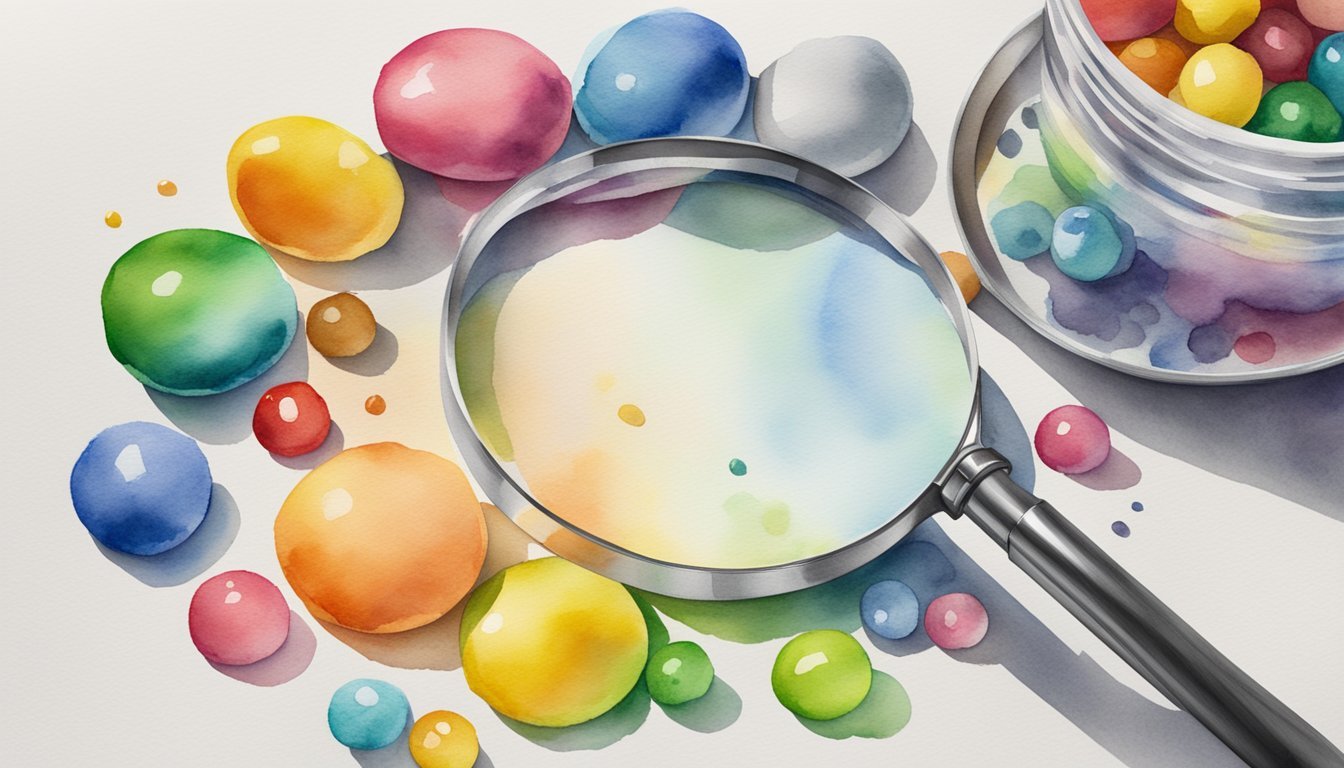Overview of Titanium Dioxide in Candies
Titanium dioxide is a common ingredient used in various candies to enhance their color and brightness, including popular brands like Skittles. Let’s unwrap what titanium dioxide is, its usage in the candy industry, and the concerns related to its safety.
What Is Titanium Dioxide?
Titanium dioxide (TiO2) is a white, powdery substance widely used as a color additive in food products to give a bright white color and opacity. This compound is found naturally in the earth’s crust and is mined for various applications, including being a critical ingredient in manufacturing candies.
Usage in Skittles and Other Candies
Skittles, produced by Mars, Inc., and many other candies have utilized titanium dioxide as a food additive to maintain a vibrant and consistent appearance. As a color additive, it helps Skittles and similar treats to achieve their signature look that appeals to consumers. The usage of titanium dioxide extends to confections, such as white-colored sauces and confectionery, providing an aesthetically pleasing finish to sweets.
Safety Profile and Health Concerns
The safety profile and health concerns regarding titanium dioxide have come under scrutiny. While the Food and Drug Administration (FDA) in the United States recognizes it as generally safe for use in food, some research suggests there could be potential health risks. The ingestion of foods containing titanium dioxide, such as candies, has raised questions about its potential toxicity and genotoxicity, leading some to worry about links to inflammation or even cancer. The European Food Safety Authority has taken steps to assess these concerns, maintaining vigilance to ensure the wellbeing of consumers.
Regulatory Perspectives and Litigation

Amidst the colorful world of candies, regulatory bodies and courts are scrutinizing a particular ingredient that’s frequently come under fire: titanium dioxide (TiO2). This small addition to treats like Skittles is proving to have large implications.
Global Regulations on Titanium Dioxide
International regulation of titanium dioxide varies significantly. The European Food Safety Authority (EFSA) designated titanium dioxide, known as E171 in food applications, as no longer safe when used as a food additive. As a result, manufacturers in the European Union face reformulation challenges since its ban in 2021. Contrastingly, FDA regulations in the United States continue to permit the use of titanium dioxide as a colorant, albeit under specific quantity and manner of use limitations outlined in the Federal Food, Drug, and Cosmetic Act.
Titanium Dioxide Lawsuits and Pending Litigation
In the U.S., pending litigation has brought the use of titanium dioxide into the legal arena. California man filed a lawsuit claiming the makers of Skittles use titanium dioxide despite evidence that it’s a known toxin, potentially misleading consumers about the candy’s safety. This follows efforts by various NGOs like the Center for Food Safety and the Environmental Defense Fund seeking greater scrutiny of food additives and colorants.
Positions of Health And Safety Organizations
Relevant health organizations have varied stances on titanium dioxide. Groups such as the Environmental Working Group and the American Academy of Pediatrics have raised concerns about the safety of food colorants, including TiO2, citing the need for stricter oversight. Conversely, the FDA has maintained TiO2’s status as generally recognized as safe (GRAS) following current regulations and evidence. However, the issue remains a contentious one, with ongoing calls for more comprehensive research and evaluation by certain parties and safety advocacy groups.
Understanding the Broader Impact and Alternatives

When it comes to the vibrant colors in foods such as Skittles, Starburst, and Jell-O, titanium dioxide plays a starring role. Titanium dioxide, a compound responsible for adding whiteness and opacity, is a common ingredient in items ranging from food additives to cosmetics and paint.
Food industries frequently use titanium dioxide to enhance the appearance of products like frosting and icing on cakes. It can render colors more pronounced, lending a bright, appealing look to sweets including Skittles and Sour Patch Kids. Outside the realm of confectionery, this compound can also be found in dairy products, like cottage cheese and certain brands of ice cream, providing a consistent, bright look.
In cosmetics, it’s included in products like toothpaste and sunscreen, while in the household goods sector, it’s found in paint and plastics. The widespread utility of titanium dioxide across various markets signifies its importance as a pigment.
Despite its various uses, concerns over the safety of titanium dioxide have led to studies exploring the potential impact on nutrition and health, particularly when ingested. Although historically deemed safe, some research questions the long-term effects, sparking debates and regulatory scrutiny.
As the market responds, alternatives are being considered. In the food industry, for instance, manufacturers are examining different dyes and natural color sources to maintain the attractiveness of their products while adhering to safety guidelines and public health concerns. Salad dressings, chewing gum, and even the colorful candy Swedish Fish may see shifts in their ingredient lists as companies seek out substitutes to titanium dioxide. This reflects a broader trend towards transparency in product formulations and artificial colors.
With such transitions, consumers are encouraged to check labels and stay informed about the composition of their favorite products, from the paint on their walls to the sunscreen protecting their skin.

